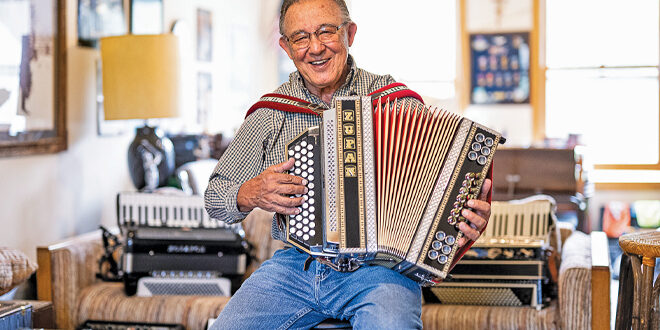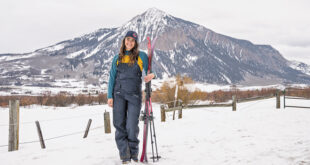By Dawne Belloise
Pete Dunda remains the long time, absolute King of Oompah for the Gunnison Valley and beyond. His accordion talent, along with his band, has ensured that Crested Butte’s favorite celebrations have the traditional polka music, allowing generations of locals to continue doing that twirling Slovanian slam dancing. But what many may not know is that Pete was also an ace fighter jet pilot and laser technician.
Born and raised in a large extended family in Pueblo, Pete’s mother was a homemaker and his father worked 45 years in the Colorado Steel and Iron mill (CF&I), the company that shipped coal from Crested Butte to Pueblo to make the steel. “The mill was comprised of many different mills that turned out different steel products. During WWII the workers were exempt from the draft,” he says. Pete explains that the mill was supporting military products. “Wire, bolts, tubes, pipe for oil and water. Most of it (the mill) now has been shut down. Today, a Russian-owned company is running what’s left of the steel mill,” he explains, but says in its heyday it was the biggest steel mill west of the Mississippi.
As a kid growing up half Slovenian and half Russian, Pete attended the Russian Orthodox church, where the service was in Russian. “The Slovenians sat on one side and the Serbians sat on the other side. In those days they got along just fine and that’s the environment I was raised in.”
Throughout his childhood, Pete’s family had a small accordion. “It only had 12 basses on the left. My dad could play about four songs he picked up by ear and he taught me to play those. All were fairly simple polkas,” he recalls. But at age 7, he began to take lessons. In the mid-1940s, Pete recalls that every kid on the block played accordion. “We had three fly-by-night schools for accordion, it was the instrument of the time and they wanted to sell you an accordion.” But his father, sensing his son’s early talent, sent him to a bonafide accordion teacher who hailed from Chicago. “I started with a 24 bass accordion. I didn’t learn a song for about two years because the teacher was a strict, fundamental, classical teacher and wanted to establish a good foundation,” he says. So Pete spent those early lessons learning and practicing scales. “By age 9, I was playing some semi-classical music, which was pretty difficult for a 9-year old.” His first talent contest win at 10 years old was also his first public performance.
In the early 1950s, the accordion was very popular, and Pete performed at his high school assemblies. “I discovered it was a chic magnet,” he laughs and adds, “It made me a little more popular and that started my career.”
But then, Pete explains, around 1955 was the death knell of the accordion, when Elvis hit the stage and eight years later, the Beatles sealed the fate of the once popular instrument. “And 99% of kids who were playing accordion dropped it and went to guitar. No one wanted to play accordion anymore and it reverted to the dance halls.”
He graduated from Central High School in 1967. Although he had no real plans after graduation, Pete knew he didn’t want to stay in Pueblo and work at the mill. “We were very poor, most families in those days were. I didn’t lack for anything and I had a great life, but college money was out of the question.” However, at graduation he was awarded a full scholarship to Pueblo Junior College (now Colorado State University at Pueblo). Pete had enjoyed playing baseball throughout his school years and his scholarship award was for the athlete with the highest GPA.
In college, Pete studied engineering, taking courses in math, chemistry and calculus to graduate with an associate’s degree in engineering in 1959. After college, he applied for military flight training and was commissioned as a second lieutenant. He eventually got his wings through Aviation Cadets, a program from which the U.S. Air Force enlisted most of their pilots and cadets. Pete notes that this was prior to the startup of the Colorado Springs Air Force Academy. Pete had enrolled at Colorado State University (CSU) in Fort Collins in 1960 and graduated with a Bachelor of Science in Electrical Engineering in 1961.
His dream was to fly the fast stuff, fighter planes. His first assignment was during the height of the Cold War, and he was sent to McClellan Air Force Base in Sacramento where he pulled 16- to 18-hour missions flying along the coastline to the tip of Alaska. “We were expecting Russian threats,” Pete explains. He flew there for four years, from 1962 to 1966. During his early college days, and training and flying, Pete was dating Susan, who was a senior at his high school while he was a freshman in college. He and Susan married in July 1962. Their son Peter was born in 1966 in Sacramento, Laura in 1968 in Gwinn, Michigan and Andrew came along in 1974.
Pete received his first fighter assignment in an F101 Voodoo in Glasgow, Montana. “It was the 13th Fighter Inceptor Squadron. All fighter squads in the U.S. were part of NORAD (North American Air Defense). We’d fly every day practicing intercepts and run exercises over Canada.” In 1968, he was reassigned to K.I. Sawyer Airforce Base in Gwinn, Michigan, until 1969. Pete also flew with the Canadians from 1970 through 1972. He had put in a request to participate in an exchange program at the Airforce Institute of Technology at Dayton, Ohio, to study laser physics, which he completed and received his degree in 1974. That was when the Star Wars fad hit and lasers were coming into vogue. “It triggered that the Russians were ahead of us,” he says of President Reagan’s initiative. “We were deficient in people who had the academic credentials in high energy laser technology.”
When Pete was sent on training to pilot the F4 Phantom jet in Phoenix, he was pleased to get back into flying. He then went from Luke Airforce base six months later in 1975 to Kunsan, South Korea, for a remote tour with the 8th Tactical Fighter Wing. One year later, he was faced with making a big decision, a choice between going to the Air Force weapons lab at Kirkland Air Force Base in Albuquerque, New Mexico, or overseas to an Air Force base in either Spain or England. “I had three small kids, two were in school, and at that time there was a lot of terrorist turmoil in Europe.” He had been away for a year, and he didn’t want to take his kids out of school to Europe, so he took the Albuquerque assignment and moved his family in April of 1976. In that top secret program, they worked on installing high energy lasers on modified Boeing 707s, and he was there until 1983. Pete still attends a laser project reunion every year in Albuquerque.
After scouting around for another assignment in Albuquerque, after he had been promoted to a Lieutenant Colonel, he became Air Force Commander for the Identification Friend, Foe or Neutral (IFFN), a program conducted by three service branches, the U.S. Navy, Air Force and Army. “It was an analysis of threats, countering threats and determining who or which object was friend, foe or neutral. It was a very complex computer simulation with great oversight from the Pentagon.”
After nine years in Albuquerque, Pete was going to be transferred to a top secret assignment as a commander of communication on the Black Range (weapons testing) in Nevada. “It was referred to as the Skunkworks, which is aerospace slang for the top-secret range. The F-117 was developed there.” But Pete chose instead to retire from the Air Force. “I took off my Air Force uniform and went to work for Titan Systems, an Aerospace company in Albuquerque for a couple years,” he says. He was there until 1988 when he moved to the BDM Corporation, another aerospace company, as the optics test director, until 1994. Switching again, he went to work for S-Systems and was there until he finally retired in ‘97.
Pete had bought five acres on the Taylor River in 1966 and had kept it all those years. And in the autumn of 1997, when he retired for good, he and Susan decided to build a house on the property and move there year-round. They’ve been here ever since. “We don’t leave in the winter,” he smiles, and that’s when he started playing his accordion a lot again.
Pete recalls, “Chris Rouse had a band and I was part of that polka band. We played maybe a couple of times a year, like Memorial Day and the Fourth of July.” Pete started his own band with sax player Frank Bregar, who still plays with him. “Frank is the vocalist because I can’t sing worth a dang.” Pat Olson, his drummer, is from Grand Junction and depending on where the gig is, he also has a Denver drummer, Michael Golub.
As octogenarians, he and Susan have a deep love for where they live. “The small community keeps me here. Growing up, I used to come fishing on the Taylor with my dad and a couple of uncles. I still fish the Taylor and the Gunnison. I tell my wife that they can drag me out by my boots, but I’m not leaving here.”
 The Crested Butte News Serving the Gunnison Valley since 1999
The Crested Butte News Serving the Gunnison Valley since 1999





